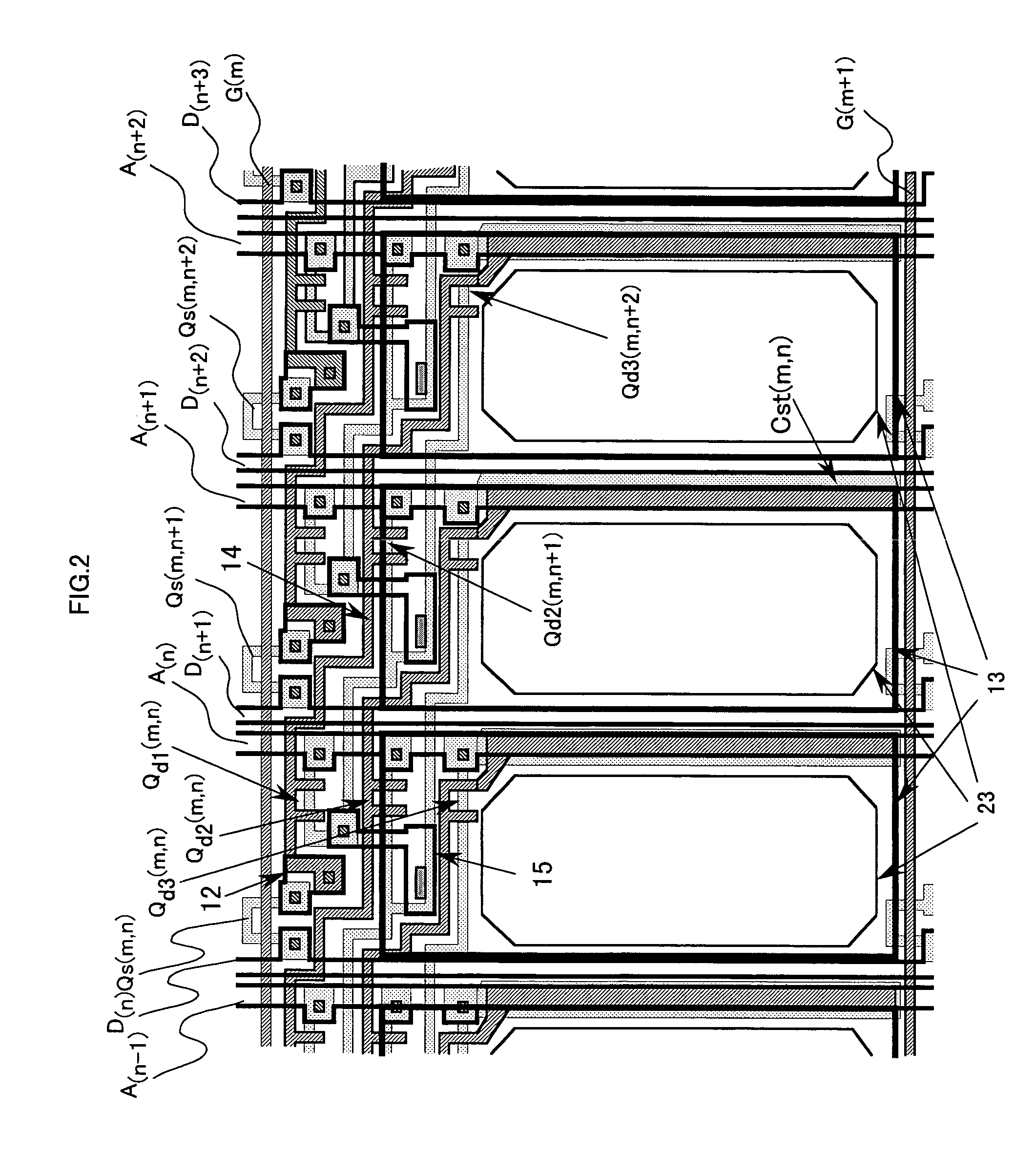Display device
a display device and display technology, applied in the field of display devices, can solve the problems of uneven representation, inability to make more than pixel pitch, and non-uniformity in a picture, and achieve the effect of free of uneven representation
- Summary
- Abstract
- Description
- Claims
- Application Information
AI Technical Summary
Benefits of technology
Problems solved by technology
Method used
Image
Examples
first embodiment
[0078]FIG. 1 is a circuit diagram showing equivalent networks for pixels in a display device according to a first embodiment of the invention, and FIG. 2 is a plan view showing a pixel arrangement in the display device according to the first embodiment of the invention.
[0079] In a self-luminescence display device according to the invention, organic electroluminescent elements (referred simply below to as EL elements) of respective pixels are driven by three drive thin-film transistors (referred below to as EL drive TFT) provided on different pixel regions.
[0080] In the first embodiment, respective EL drive TFTs are arranged in an associated pixel, the next pixel on the right side and the further next pixel but one on the right side.
[0081] In FIG. 1, there are shown three pixel regions surrounded by scanning signal wiring electrodes (Gm, G(m+1)), picture signal wiring electrodes (Dn to D(n+1)), and anode current feeding wiring electrodes (A(n−1) to A(n+2)), which constitute a part...
second embodiment
[0107]FIG. 4 is a circuit diagram showing equivalent networks for pixels in a display device according to a second embodiment of the invention, and FIG. 5 is a plan view showing a pixel arrangement in the display device according to the second embodiment of the invention.
As described above, with the self-luminescence display device according to the invention, EL elements of respective pixels are driven by three EL drive TFTs provided on different pixel regions.
[0108] In the embodiment, respective EL drive TFTs are arranged in an associated pixel, and the next pixels on the right and left sides.
[0109]FIG. 4 shows three regions of pixels surrounded by scanning signal wiring electrodes (Gm, G(m+1)), picture signal wiring electrodes (D(n−1) to D(n+2)), anode current feeding wiring electrodes (A(n−2) to A(n+1)), which constitute a part of the matrix.
[0110] A pixel in row m and column n is defined by a region, which is surrounded by scanning signal wiring electrodes (Gm, G(m+1)), a p...
third embodiment
[0162]FIG. 10 is a circuit diagram showing equivalent networks for pixels in a display device according to a third embodiment of the invention, and FIG. 11 is a plan view showing a pixel arrangement in the display device according to the third embodiment of the invention.
[0163] With the self-luminescence display device according to the embodiment, an EL element OLED(m, n) in row m and column n is driven by five parallel EL drive TFTs formed in total five regions of pixels in row m and column (n−2), row m and column (n−1), row m and column (n+1), and row m and column (n+2) as well as in row m and column n.
[0164] Since the number in parallel is five, such averaging greatly contributes to improvement in uniformity, which makes it possible to obtain an enhanced uniform display characteristics.
PUM
 Login to View More
Login to View More Abstract
Description
Claims
Application Information
 Login to View More
Login to View More - R&D
- Intellectual Property
- Life Sciences
- Materials
- Tech Scout
- Unparalleled Data Quality
- Higher Quality Content
- 60% Fewer Hallucinations
Browse by: Latest US Patents, China's latest patents, Technical Efficacy Thesaurus, Application Domain, Technology Topic, Popular Technical Reports.
© 2025 PatSnap. All rights reserved.Legal|Privacy policy|Modern Slavery Act Transparency Statement|Sitemap|About US| Contact US: help@patsnap.com



